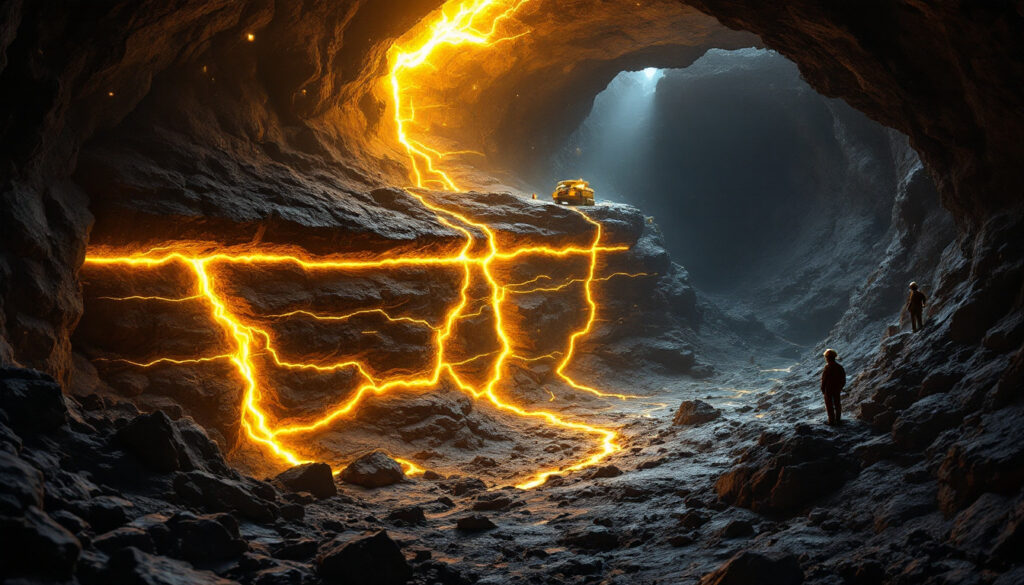What is a Cut-Off Grade in Mining?
Definition and Basic Concept
A cut-off grade is the minimum grade of mineralization that can be economically mined and processed. It represents the critical threshold that determines which parts of a mineral deposit are included in a resource estimate and which are excluded. This fundamental concept forms the backbone of resource modeling in the mining industry.
Cut-off grades are expressed in units specific to the commodity being mined. For precious metals like gold and silver, they're typically measured in grams per tonne (g/t), while base metals such as copper, zinc, and lead use percentage values.
The determination of cut-off grades isn't arbitrary—it's a calculated decision based on economic principles that separate valuable mineralization from waste rock. By understanding the JORC Code for resource estimation, investors can better evaluate how companies apply these principles in their reporting.
Economic Significance
Cut-off grades serve as the economic dividing line between ore and waste. This distinction is crucial because it directly influences the size and quality of a JORC-compliant resource. A higher cut-off grade results in a smaller but higher-grade resource, while a lower cut-off grade produces a larger but lower-grade resource.
The economic significance of cut-off grades extends to drilling programs as well. They determine which drilling intercepts can be incorporated into resource models, affecting exploration strategies and development decisions.
For investors, understanding the economic implications of cut-off grades is essential. A resource estimate using a 0.5 g/t gold cut-off will report a significantly different resource than one using a 3.5 g/t cut-off for the same deposit—even though the physical rock hasn't changed.
How are Cut-Off Grades Determined?
Mining Cost Factors
The calculation of cut-off grades begins with a thorough assessment of all costs associated with mining and processing the ore:
- Extraction costs per unit of ore (typically $20-75 per tonne depending on mining method)
- Processing and refining costs ($15-30 per tonne for typical gold operations)
- Transportation and logistics expenses (adding 5-15% to total costs)
- Capital expenditure requirements (amortized over the life of mine)
- Labor and operational costs (including maintenance, supervision, and administration)
These cost components create the economic foundation for cut-off grade determination. According to the SME Mining Engineering Handbook, the basic formula for cut-off grade calculation is: "Cut-off grade = (Costs – Byproduct Credits) ÷ (Commodity Price × Recovery)."
Revenue Factors
The revenue side of the equation includes:
- Current and projected commodity prices (often using 3-year trailing averages)
- Recovery rates during processing (typically 85-95% for gold, lower for complex ores)
- Payability terms with smelters/refiners (especially relevant for concentrate producers)
- By-product credits and penalties (can significantly impact economics for polymetallic deposits)
The interplay between costs and revenue creates the economic framework for determining viable cut-off grades. When commodity prices rise, lower-grade material becomes economic; when prices fall, only higher-grade material remains profitable. This relationship is central to expert insights on mining economic viability across different market conditions.
Technical Considerations
Beyond pure economics, several technical factors influence cut-off grade selection:
- Mining method requirements (underground methods typically require higher grades than open pit)
- Metallurgical recovery factors (complex ores may need higher grades to offset lower recoveries)
- Geotechnical constraints (depth, ground conditions, and slope stability requirements)
- Environmental permits and regulations (compliance can add $2-5 per tonne to operating costs)
These technical considerations often necessitate different cut-off grades for different portions of the same deposit, reflecting varying extraction and processing costs.
How Does Deposit Depth Affect Cut-Off Grades?
Shallow vs. Deep Deposits Comparison
The depth of a mineral deposit has a profound impact on the cut-off grade required for economic extraction. This relationship follows a clear pattern:
Shallow deposits typically have lower cut-off grades due to reduced mining costs. Open-pit mining methods are less expensive per tonne of material moved, allowing companies to profitably extract lower-grade material.
Deep deposits require higher cut-off grades to offset increased mining expenses. Underground mining costs escalate with depth due to ventilation requirements, ground support, material handling, and dewatering needs.
This relationship creates a depth-cost correlation that mining companies must carefully consider:
| Depth | Typical Cost Range |
|---|---|
| 0-300m | $20-35/tonne |
| 300-1000m | $35-75/tonne |
| >1000m | $75-120+/tonne |
Real-World Examples
Two prominent Australian gold miners illustrate this principle perfectly:
Bellevue Gold's underground resource uses a 3.5 g/t cut-off grade for deposits located 200-1000m below surface. This higher cut-off reflects the increased costs associated with accessing deeper mineralization through underground mining methods.
In contrast, Ramelius Resources' open pit project employs a much lower 0.5 g/t cut-off grade for near-surface mineralization to a depth of approximately 325m. The lower extraction costs of open-pit mining make this lower grade economically viable.
The seven-fold difference in cut-off grades between these projects demonstrates how mining method and depth directly influence cut-off grade selection. This isn't merely an academic distinction—it fundamentally changes what constitutes "ore" versus "waste."
Internationally, this pattern holds true. South Africa's Mponeng Mine, one of the world's deepest at over 4km depth, uses a cut-off grade of approximately 4.5 g/t gold, while Indonesia's Grasberg open-pit operation can profitably mine material at just 1.2 g/t.
Why is Cut-Off Grade Critical for JORC Resources?
Resource Estimation Impact
The cut-off grade selected for resource reporting directly determines which drilling intercepts can be included in the resource model. This fundamental decision has cascading effects throughout the entire resource estimation process.
According to industry consultants AMC (2024), a 10% reduction in cut-off grade can increase a resource by 25-40% without any additional drilling. This sensitivity makes cut-off grade selection one of the most influential factors in resource reporting.
JORC-compliant resources must disclose the cut-off grade used, providing a standardized approach for economic evaluation. This transparency allows investors to understand the economic assumptions underlying the resource estimate.
The distinction between resource categories (Measured, Indicated, and Inferred) is also affected by cut-off grades, with each category potentially using different thresholds based on confidence levels. For those new to the industry, a beginner's guide to understanding mining drilling results can provide context on how these results are incorporated into resource models.
Case Study: Los Cerros (ASX:LCL)
A compelling example of cut-off grade impact comes from Los Cerros Limited (ASX:LCL) and their Quinchia Gold Project in Colombia. When the company changed the cut-off grade from 0.5 g/t to 0.25 g/t, the resource increased by approximately 1 million ounces of gold—a substantial addition without drilling a single new hole.
This case demonstrates how small changes in cut-off grade can dramatically affect reported resource size. The lower cut-off grade allowed previously sub-economic material to be included in the resource, effectively converting "waste" to "ore" through a change in economic assumptions rather than physical discovery.
For investors, this case highlights the importance of scrutinizing the economic assumptions behind resource estimates. A resource that grows substantially through cut-off grade reduction rather than new discoveries may not represent the same value proposition.
How Do Commodity Prices Affect Cut-Off Grades?
Price-Grade Relationship
There exists an inverse relationship between commodity prices and cut-off grades. As prices rise, lower-grade material becomes economic to mine; as prices fall, only higher-grade material remains profitable.
This relationship is based on the revenue-to-cost ratio. When revenue per unit of metal increases due to higher commodity prices, the grade required to cover costs decreases proportionally.
The price-cut-off relationship can be quantified. For gold, industry data suggests this approximate relationship:
| Gold Price | Economic Cut-off (Underground) |
|---|---|
| $1,800/oz | 1.2 g/t |
| $2,100/oz | 1.0 g/t |
| $2,400/oz | 0.7 g/t |
Similar patterns exist across commodities. For copper:
| Copper Price | Economic Cut-off |
|---|---|
| $4/lb | 0.4% |
| $6/lb | 0.3% |
| $8/lb | 0.25% |
Hypothetical Gold Mine Example
Consider a hypothetical gold mining operation with extraction and processing costs of $50 per gram of gold produced:
Scenario A: At a gold price of $25 per gram with $50 per gram extraction cost, a minimum 2 g/t cut-off is required to break even (since $25 × 2g = $50).
Scenario B: At a gold price of $100 per gram with the same costs, a 0.5 g/t cut-off becomes economic (since $100 × 0.5g = $50).
This simplified example illustrates how rising commodity prices can transform previously uneconomic material into valuable ore. The physical rock hasn't changed—only the economic environment.
Resource Size Variability
Due to this price sensitivity, resources can grow significantly during commodity price upswings without additional drilling. Many companies recalculate resources during bull markets using lower cut-off grades, effectively growing their asset base.
Conversely, during price downturns, the same deposit may report a smaller economic resource as higher cut-off grades become necessary to maintain profitability.
According to industry data, approximately 70% of ASX-listed miners revised their cut-off grades by more than ±0.1g/t in 2024, reflecting the dynamic nature of resources in response to market conditions. Understanding gold market analysis and future trends can provide investors with context for evaluating these adjustments.
This variability presents both opportunities and risks for investors. Understanding that resources aren't static physical entities but dynamic economic constructs is essential for proper valuation.
What Other Factors Influence Cut-Off Grade Selection?
Location and Infrastructure
The geographical location of a deposit and surrounding infrastructure significantly impact cut-off grade selection:
Remote locations with poor infrastructure require higher cut-off grades to offset increased costs. Industry data suggests remote operations face cost premiums of approximately 35% compared to established mining districts.
Established mining districts with existing infrastructure can support lower cut-off grades due to reduced development and operating costs. Access to power, water, transportation, and skilled labor creates substantial economic advantages.
Transportation costs to processing facilities or markets become particularly significant for bulk commodities. For instance, iron ore mines located far from ports typically require higher grades to remain competitive with more advantageously positioned competitors.
Regulatory Environment
The regulatory framework governing mining operations influences cut-off grade decisions in several ways:
- Environmental regulations and permitting requirements add compliance costs that must be factored into economic assessments.
- Royalty and taxation structures directly impact project economics, with higher government takes necessitating higher cut-off grades.
- Social license considerations, including community agreements and benefit-sharing arrangements, add costs that affect economic thresholds.
The permitting timeline also varies dramatically by jurisdiction. Nevada operations typically secure permits in around 18 months, while Queensland projects might require 36 months—affecting the carrying costs that must be incorporated into economic models.
Operational Considerations
Several operational factors influence cut-off grade selection:
- Processing plant capacity and throughput determine the optimal feed grade to maximize overall value.
- Mine life objectives may lead companies to prioritize higher-grade material early in the mine life (high-grading) or adopt a more balanced approach.
- Company strategy regarding high-grade/low-tonnage versus low-grade/high-tonnage operations reflects different approaches to value creation.
Increasingly, ESG (Environmental, Social, Governance) factors account for 5-12% of cut-off grade calculations, reflecting the growing importance of sustainability metrics in mining economics.
How Should Investors Interpret Cut-Off Grades?
Red Flags and Warning Signs
When evaluating mining projects, investors should watch for these cut-off grade red flags:
- Unusually high or low cut-off grades compared to peer projects with similar mining methods and depths.
- Frequent changes to cut-off grades in successive resource estimates without corresponding changes in project economics.
- Cut-off grades based on unrealistic commodity price assumptions that significantly exceed long-term averages.
- Cut-off grades below 0.3 g/t gold equivalent without heap-leach capability, which typically indicates optimistic economic assumptions.
These warning signs often indicate that companies may be manipulating cut-off grades to present their project in the most favorable light rather than using realistic economic parameters.
Comparative Analysis
Effective due diligence requires comparative analysis:
- Compare cut-off grades with similar projects in the same region using the same mining method.
- Evaluate the sensitivity of the resource to changes in cut-off grade (companies should provide grade-tonnage curves).
- Consider how the cut-off grade might change with future commodity price movements.
A well-considered approach involves checking whether the cut-off grade falls within ±15% of regional peers with similar operations. Greater deviations require careful scrutiny and justification.
Due Diligence Questions
Savvy investors should ask these key questions when evaluating cut-off grades:
- Is the chosen cut-off grade appropriate for the deposit type and mining method?
- How does the resource change at different cut-off grades? (Look for grade-tonnage curves in technical reports)
- What commodity price assumptions underpin the cut-off grade selection?
- Has the cut-off grade changed over time, and if so, why?
- Do different zones of the deposit use different cut-off grades, and is this approach justified?
Companies with robust technical documentation will address these questions transparently in their resource statements and technical reports. For comprehensive strategies, navigating mining investments and geological insights provides additional guidance on evaluating these technical aspects.
FAQ About Cut-Off Grades
What happens if commodity prices change after a resource is published?
Resources may be re-estimated using updated economic parameters when significant price changes occur. Companies typically review their economic assumptions annually or when market conditions change substantially.
Higher prices can lead to resource expansions with lower cut-off grades, potentially converting previously uneconomic material into the resource category without additional exploration.
Lower prices may result in resource contractions with higher cut-off grades, as material that was previously marginally economic becomes uneconomic.
Most major mining companies maintain internal "price decks" with different scenarios to understand resource sensitivity to price fluctuations.
Can different parts of the same deposit have different cut-off grades?
Yes, different mining methods or zones frequently use different cut-off grades within the same deposit. This practice reflects varying extraction costs and processing requirements.
Open pit portions may use lower cut-offs than underground sections due to the significant cost differential between these mining methods. This approach is common in "combination" mines that transition from open pit to underground operations.
Processing variations might require different cut-off grades for different ore types. Oxide, transitional, and sulfide ores often have different metallurgical characteristics and recovery rates, necessitating separate economic thresholds.
How do new technologies affect historical cut-offs?
Technological advancements can significantly impact cut-off grades. Sensor-based sorting technology at operations like Karara Iron enabled approximately 20% lower cut-offs in 2023 by allowing pre-concentration of ore before processing.
Improved metallurgical processes, automation, and more efficient mining methods can all contribute to lowering economically viable cut-off grades, effectively expanding resources without additional exploration.
How do cut-off grades differ between commodities?
Precious metals typically use g/t (grams per tonne), with economic thresholds ranging from 0.3-5 g/t for gold depending on mining method and depth.
Base metals often use percentage values, with copper typically ranging from 0.2-1.0%, zinc from 1-4%, and lead from 1-3%.
The economic threshold varies widely between commodities based on value and recovery costs. For instance, platinum group metals can be economic at lower concentrations than gold due to their higher unit value, despite more complex metallurgy.
Key Takeaways
Essential Points for Investors
Cut-off grades in mining determine the economic viability of mineral deposits, serving as the dividing line between ore and waste. They directly influence the size and quality of reported resources, making them critical for project valuation.
Lower cut-off grades result in larger but lower-grade resources, potentially increasing total contained metal but reducing the average grade. Higher cut-off grades produce smaller but higher-grade resources, potentially improving project economics but reducing the overall resource size.
Cut-off grades change based on mining method, commodity prices, and operational costs. They aren't static values but dynamic thresholds that respond to economic conditions.
When evaluating mining
Ready to Spot the Next Major Mineral Discovery?
Gain immediate access to real-time alerts on significant ASX mineral discoveries through Discovery Alert's proprietary Discovery IQ model, transforming complex geological data into actionable investment opportunities. Visit the Discovery Alert discoveries page to explore how historic mineral discoveries have generated substantial returns and begin your 30-day free trial today.




